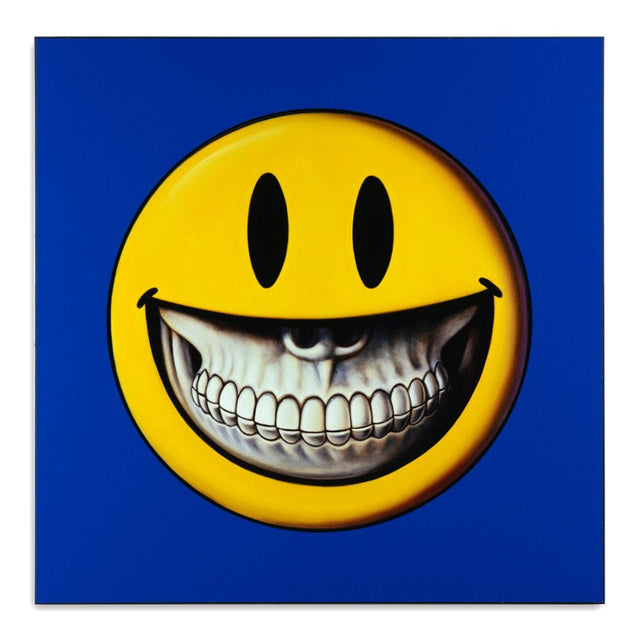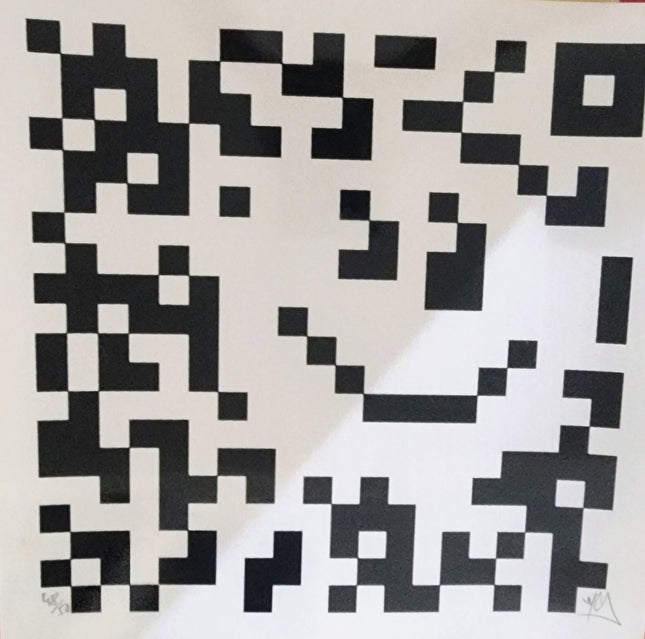
Smiley Face

RYCA- Ryan Callanan QR Code Smiley Silkscreen Print by RYCA- Ryan Callanan
QR Code Smiley Silkscreen Print by RYCA- Ryan Callanan Hand-Pulled 1-Color on Fine Art Paper Limited Edition Artwork. 2022 Signed & Numbered Limited Edition of 50 Artwork Size 9.75x9.75 Silkscreen Print RYCA's QR Code Smiley Silkscreen Print: A Confluence of Technology and Street Pop Art The QR Code Smiley Silkscreen Print by RYCA, also known as Ryan Callanan, is a striking example of how contemporary artists blend digital motifs with traditional printmaking techniques. RYCA's decision to capture the essence of a QR code, an emblem of the digital age, and transform it into a piece of street pop art & graffiti artwork is innovative and reflective of our times. The smiley face hidden within the code's design adds a layer of playfulness and nostalgia, reminding us of the early days of digital communication while commenting on technology's pervasive nature in modern life. This artwork, a 2022 limited edition of 50, has been created through the labor-intensive process of hand-pulled silkscreen printing. Each print, signed and numbered by the artist, measures 9.75x9.75 inches and is printed on fine art paper. The choice to work in a monochromatic palette emphasizes the starkness and immediacy of the QR code, contrasting the often colorful and chaotic imagery found in street art. However, this very simplicity allows the piece to stand out, offering a visual pause in the frenetic visual language of urban environments. RYCA's Artistic Journey and the Intersection with Street Art RYCA's journey as an artist has been marked by his ability to infuse familiar cultural icons with new meaning. By taking a universally recognizable symbol such as the QR code and embedding the iconic smiley face within it, he bridges the gap between art and the audience, making his work both accessible and engaging. This piece is a testament to RYCA's skill in using pop art sensibilities to comment on the intersection of technology and human emotion, a prevalent theme in the digital age. The limited run of this print makes it a coveted item for collectors and reinforces the transient nature of street art, where the rarity and location of a piece can significantly enhance its value and impact. RYCA's work is a reminder of the transient nature of graffiti artwork, often here today and gone tomorrow, mirroring the fleeting nature of digital information in the internet age. The QR Code Smiley Silkscreen Print is more than a visual statement; it is a cultural artifact that encapsulates the zeitgeist of the 21st century. QR codes have become ubiquitous in our lives, a technical solution to a cultural desire for quick, seamless access to information. By incorporating this symbol into his art, RYCA comments on its pervasive nature and challenges the viewer to consider the relationship between the digital and physical worlds. With its minimalist aesthetic and conceptual depth, this print reflects a broader trend in street pop art & graffiti artwork, where artists are increasingly engaging with digital culture. RYCA's work is at the forefront of this movement, blending street art's immediacy with the connectivity of digital technology. RYCA's QR Code Smiley and Its Place in Modern Art As street pop art & graffiti artwork continue to evolve, artists like RYCA are leading the charge, breaking down barriers between art forms and exploring new mediums. The QR Code Smiley Silkscreen Print is a powerful example of this evolution, where a technology tool is repurposed into a medium for artistic expression. The print represents RYCA's creative vision and a commentary on the increasingly blurred lines between the virtual and the real. In a world where digital interactions often replace physical ones, RYCA's print serves as a poignant reminder of the importance of tangible art in a digital age. It stands as a bridge between two seemingly disparate worlds, inviting the viewer to reflect on the role of art in a society dominated by screens and codes. RYCA's QR Code Smiley Silkscreen Print is a defining piece within the genre of street pop art & graffiti artwork, offering a unique perspective on the intersection of art, technology, and culture. Its existence as a limited edition print further underscores the value placed on originality and authenticity in art. Through this work, RYCA invites us to ponder the pervasive nature of digital symbols in our lives and how they can be reimagined through the lens of art.
$74.00


